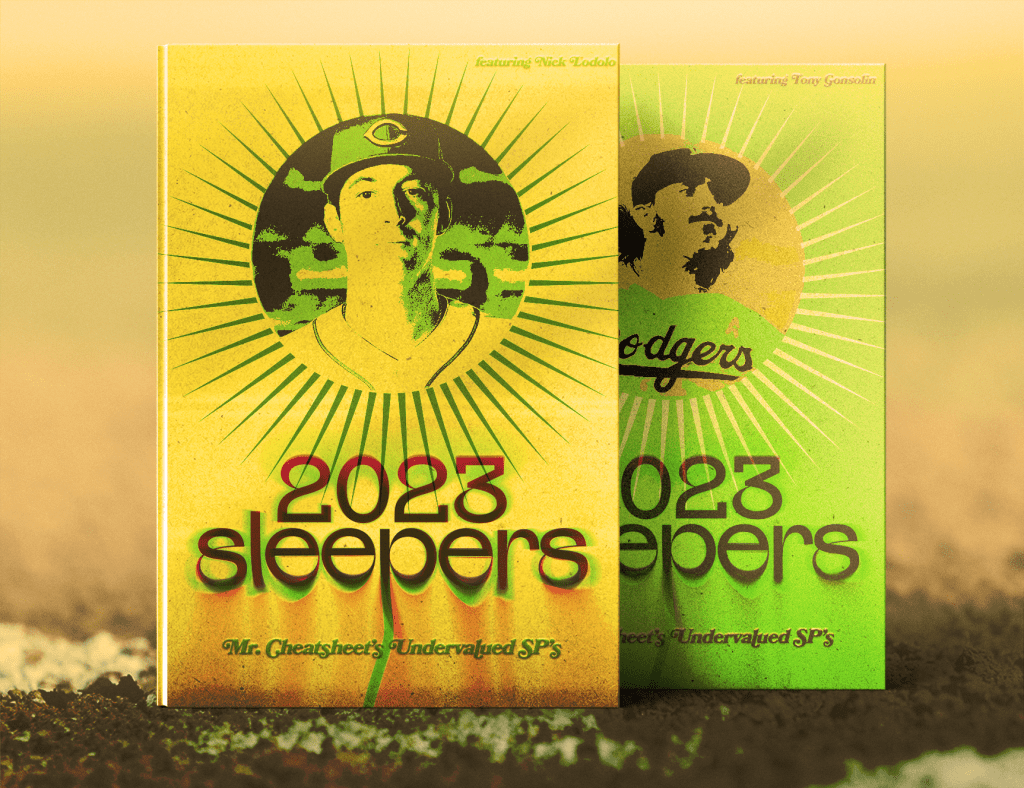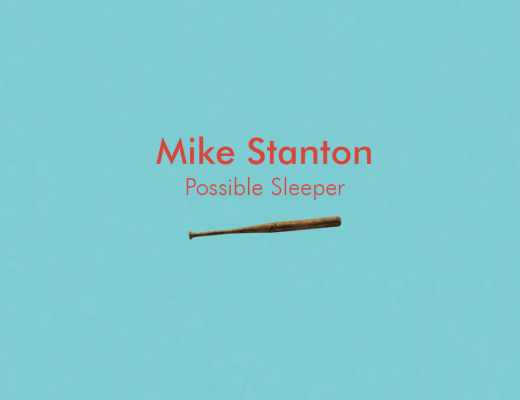
This little website is more than just a place to host free fantasy baseball cheatsheets for the world. It’s also a place to do some fantasy baseball research and analysis every single year. I started doing fantasy baseball research nearly twenty years ago and it was a different world back then. We didn’t have such a rich database of statistics readily available to us and, in a way, that was a good thing. It required some creative thinking and some hard analysis to uncover new things about the fantasy baseball world.
During that time, I started to develop mathematical formulas that would allow me to crack the code of what players might be poised to have a breakout season the year ahead. I tried loads of different ways and each had its own level of success. Over the years, it resulted in me coming up with a neat way of picking sleeper hitters for fantasy baseball.
I struggled with a way to uncover the year’s sleeper pitchers though. I was eventually inspired by some writings by Tristan Cockcroft. He had a yearly article called “Kings of Command” that set benchmarks in certain stats and identified the pitchers who exceeded them. This gave me a new idea to try out and I liked it in my initial testing. It took years of diving deep into the numbers but I eventually found my own set of benchmarks that let me identify the undervalued starting pitchers for the upcoming season.
How Do I Select My Sleeper Pitchers?
Each season, a pitcher ends up with a certain ERA and WHIP. Oddly enough, those numbers are not totally in the pitcher’s control. He can’t control the type of swing the hitter makes. He can’t control what his fielders do. He can just throw a pitch and hope for the best. In general, ERA and WHIP represent how good the pitcher did but there are other factors involved each year. This has been known for quite some time.
So, instead of analyzing the pitcher’s ERA and WHIP, I started analyzing the factors that were actually in control of the pitcher. They had more control over balls and strikes and, to a degree, how often a hitter made contact with the pitch. I started to dive deeper and deeper into analyzing stats on a pitch-by-pitch level.
Over time, I identified a grouping of statistics that I felt had the best correlation to future success. That was a good start. I quickly found that general benchmarks in a stat wasn’t helpful because each season of baseball is a little different, statistically speaking. To account for that, I came up with benchmarks that looked at the league average for these helpful statistics each year and I looked at which players exceeded those averages to a large degree.
These are the predictive stats that I found most helpful:
- K-BB% – In my research, this stat has the strongest correlation to next season’s ERA, WHIP, and K/9. It is the percentage of strikeouts per PA minus the percentage of walks per PA.
- Contact% – For each pitch that a pitcher throws, this stat tells us how often the hitter made contact with the pitch.
- Swinging Strike% – This stat calculates how often a hitter swings and misses at a pitch that a pitcher threw.
- Ball In Play% – Of all the strikes thrown by the pitcher, this looks at how many of those were from balls hit into play.
- Strikes to Balls Ratio – I take the number of strikes the pitcher thrown by a pitcher and divide that by the number of balls thrown.
- 0-2 Counts Forced% – For each batter that a pitcher faces, this stat measures how often the plate appearance went to an 0-2 count.
- Hard Hit% – Of balls hit against the pitcher, this is a measurement of the quality of contact for each of them and how often the ball was hit hard.
To conjure up my 2023 sleeper pitchers, I calculated the 2022 league averages and standard deviations for each stat and then I created benchmarks based on those for each stat. These benchmarks vary a bit for each statistic, based on how important it is. Here are the benchmarks for this year’s analysis:
- K-BB above 15.8%
- Contact under 76.2%
- Swinging Strike above 11.5%
- Ball-in-Play under 27.3%
- Strikes-to-Balls Ratio above 1.74
- 0-2 Counts Forced above 25.5%
- Hard Hit under 31.1%
Of these seven benchmarks, I narrow my list down to the pitchers who qualified in at least six of them. If a pitcher qualified in six of those statistics then they are officially on my list of pitchers that I expect to do well in the upcoming season. Most of the top 25 pitchers would end up on this list. It starts to get more interesting once we get to pitchers that show up on the list despite being drafted somewhat late in most fantasy drafts. Those special pitchers become my undervalued pitchers and my sleepers.
If you’ve been around this site long enough, you’ll also know that I love to refer to my deep sleepers as “narcos” because they’re so sleepy that they are narcoleptic.
Does It Really Help Find The Best Pitchers?
Yeah. I mean, it’s not a foolproof system as baseball is always a bit more random than we’d all like. But, in general, the pitchers that I identify as sleepers tend to have pretty good seasons and, sometimes, breakout seasons.
Using an updated version of the sleeper calculations, these are the pitchers who would have met the mark last preseason and how they ended up performing that year:

Sure, Sean Manaea may not have been a great pick at 139 and Alex Wood would have been a waste of a pick at 213 but, on the whole, you were getting great value out of almost all of these pitchers. You have pitchers in that list who were in the conversation for the Cy Young Award despite not being drafted as a Top 100 player in the preseason.
That’s great. As we’ve found every year, it confirms that we can find sleepers using data. Hooray!
But, yes, randomness and weirdness exist so there will be duds in my list of sleepers every year mixed in with some stars. Let’s see this year’s list and try to figure out which of them will save our 2023 seasons.
2023 Undervalued Pitchers To Target
There are 17 SP’s being drafted after the 100th pick on average this season who met my stringent sleeper criteria. In other words, we’ve got 17 sleeper pitchers to target this year.
SP Sleepers in the 101-150 ADP Range
Let’s start with the pitchers that might be able to anchor your rotation this year despite being drafted after the 100th pick. In the 101-150 ADP range, you’re likely drafting these pitchers as low-end starters for your team but they could deliver high-end value.
- Clayton Kershaw (LAD, SP1, Age 35) – 101 ADP
- Luis Severino (NYY, SP2, Age 29) – 113 ADP
- Kyle Wright (ATL, SP4, Age 27) – 116 ADP
- Nick Lodolo (CIN, SP2, Age 25) – 129 ADP
- Lance Lynn (CHW, SP2, Age 35) – 131 ADP
- Tony Gonsolin (LAD, SP3, Age 28) – 143 ADP
- Lucas Giolito (CHW, SP3, Age 28) – 144 ADP
Lots of pitchers to love here. Let’s start by addressing why they aren’t being drafted as top pitchers first.
Many of these pitchers did not pitch a full season last year (Severino, Lynn, Gonsolin, Lodolo, Kershaw), and that affects the public’s view of them. Some of those haven’t pitched full seasons in years (Severino, Kershaw, Lynn). Some of those haven’t pitched full MLB seasons ever (Lodolo, Gonsolin).
Some of them had a pretty poor ERA last year (Giolito, Lynn). Some of them did well but don’t have a long track record of great seasons (Wright).
Because of these lingering questions about them, the public would prefer to draft players with fewer questions attached to them. That logic makes sense but it’s where we take advantage.
Look, every pitcher in the league is an injury risk. It’s part of the game in some way. So, I don’t mind taking a chance on Clayton Kershaw, Kyle Wright, or Luis Severino and seeing how the season goes. If I’m drafting them as my SP3 then it’s not a huge tragedy if they only pitch 120 amazing innings instead of 180 (if they pitch 180 then we are ecstatic though).
I love a young talented pitcher that hasn’t had a full MLB season yet (that’s why Shane McClanahan was my favorite sleeper last year). This year’s young potential breakout star that I’m excited about is Nick Lodolo. You can get him cheap now but that may not be the case next year once he’s had a full season. This is the one you want to invest in if you’re in a keeper league.
Players that come up in my calculations that are coming off a season where their numbers didn’t look great are also really nice targets on draft day. Both of the White Sox pitchers on this list (Lance Lynn and Lucas Giolito) are a bit undervalued given their talent level and potential regardless of how they pitched in 2022.
The one player that I’m unsure about is Tony Gonsolin because, surprise, he’s opening the season on the IL. It’s only an ankle injury so it doesn’t appear to be threatening to the long-term season outlook for him. I’m optimistic that he may be a great value pitcher but it depends on how much that injury affects his draft spot in your league. I’d likely look for him after the 150th pick though.
SP Sleepers in the 151-200 ADP Range
Once we get past the top 150 players in a draft, the players that are left over are usually there for a pretty good reason. That’s where we have to look past our preconceived notions and embrace the power of the sleeper process. These are the four pitchers being drafted in the murky 151-200 ADP range that may be worth a deeper look:
- Charlie Morton (ATL, SP2, 39 years old) – 155 ADP
- Jeffrey Springs (TB, SP4, 30 years old) – 157 ADP
- Pablo Lopez (MIN, SP1, 27 years old) – 162 ADP
- Jordan Montgomery (STL, SP3, 30 years old) – 169 ADP
Okay, let’s start with the reasons they’re all not being drafted as top pitchers. Charlie Morton is old and his numbers declined last year so there’s fear that his immorality is over. Jeffrey Springs started 25 games after starting 2 in his whole career prior. Pablo Lopez took a step back last year so people feel burned by him if they used a high pick on him before. Jordan Montgomery had the Yankees seemingly give up on him.
Good, we got that out of the way. Any of these guys are actually nice bets to take in these later rounds.
Charlie Morton and Pablo Lopez had core numbers that were just as good as ever last year, even if their final results weren’t. You can gamble on them safely at a little bit of a reduced value. Jeffrey Springs does not have a long history as a starter but his numbers are hard to ignore, and I’m willing to gamble on that continuing. I don’t totally get why Jordan Montgomery isn’t being drafted higher but, hey, we’ll take it as he seems like a safe bet for a 3.50 ERA or lower.
At their price point, there’s less risk here regardless and there’s a lot of potential for reward so these are players worth gambling on despite any of their flaws.
SP Sleepers in the 201-300 ADP Range
If it’s not obvious, as we get deeper into the draft, we find pitchers with more obvious flaws on their record that make them higher risks. Even though there are sleepers here, the odds of them breaking out are a little lower.
- Jon Gray (TEX, SP3, 31 years old) – 205 ADP
- Andrew Heaney (TEX, SP5, 31 years old) – 220 ADP
- Aaron Ashby (MIL, SP?, 24 years old) – 277 ADP
Jon Gray seems to pop up on my sleeper lists every year but his years in Colorado were never kind to him. The change of scenery last year did help as he improved to a 3.96 ERA and 1.13 WHIP to go with 9.5 K/9 but he only pitched 127 innings. I think the limited innings and his past reputation are making drafters shy away from him a bit. But, at his core, he seems to be a great pitcher and he very well could have a late-career resurgence if he pitches a full season. I love him at his current draft spot.
Andrew Heaney is another player who seems to always pop up on my sleeper lists but he has never had one single breakout year and that’s mostly been due to injury. He’s got a new team this year and we can’t know if he’ll stay healthy but it’s worth a gamble this late in the draft so I feel like he’s a good one to target here.
Aaron Ashby has a shoulder injury and likely won’t be back until at least May. So, while he shows up in my sleeper calculations, I don’t know if I’d want to take a chance on drafting him unless it was a league with a number of IL spots.
SP Sleepers after the 300th pick (or players to watch)
The pitchers that are available after the 300th pick are often better left undrafted because they are such a longshot at having great seasons, but some leagues are deeper than others. In those deep leagues, you need to take a chance on some guys in those later rounds so here are a few more SP’s to consider:
- Bailey Ober (MIN, SP?, 27 years old) – 336 ADP
- Braxton Garrett (MIA, SP?, 25 years old) – 367 ADP
- Tarik Skubal (DET, RP, 25 years old) – 386 ADP
At one point in time, we found guys like Kevin Gausman being drafted this late so we always hope to find some talent here. These three pitchers are being drafted this late because they just don’t have any track record of MLB long-term success yet or they don’t have solid roster spots.
Bailey Ober and Braxton Garrett may be great but will they even make their respective teams? If they’re not in the starting rotation for the Twins or Marlins, there’s little reason to draft them. If they do make the rotation then those are lottery tickets worth taking at these draft spots.
On the flipside, Tarik Skubal will start the season on the 60-Day IL so he’s only really worth drafting if you can stash him on the IL and hope for the best.
Let’s Rock
We can never say how a season is going to go and there’s never going to be a 100% success rate on a list of sleepers but I feel pretty confident in saying that a lot of these players will end up having very good seasons in 2023. Take a gamble on a few of them and hope that you find the right ones!
Good luck, y’all!



